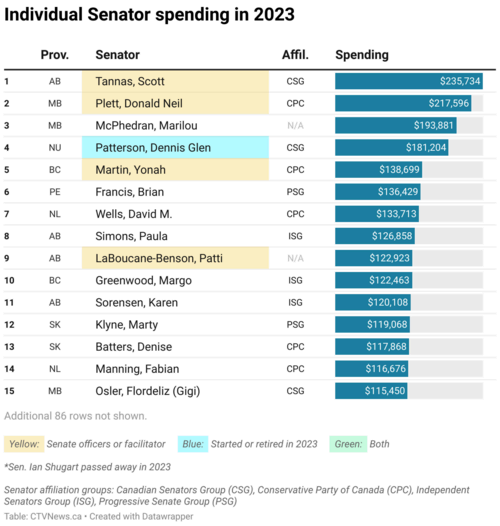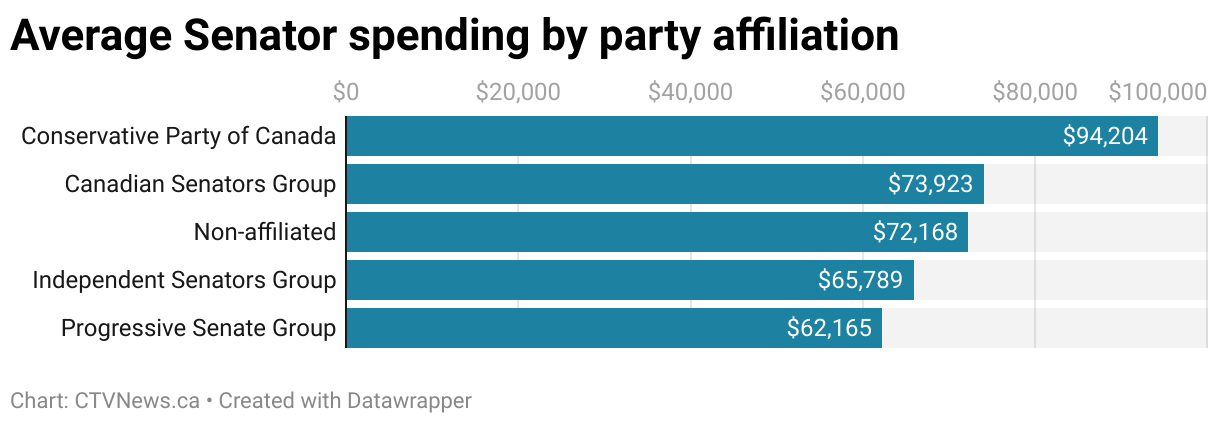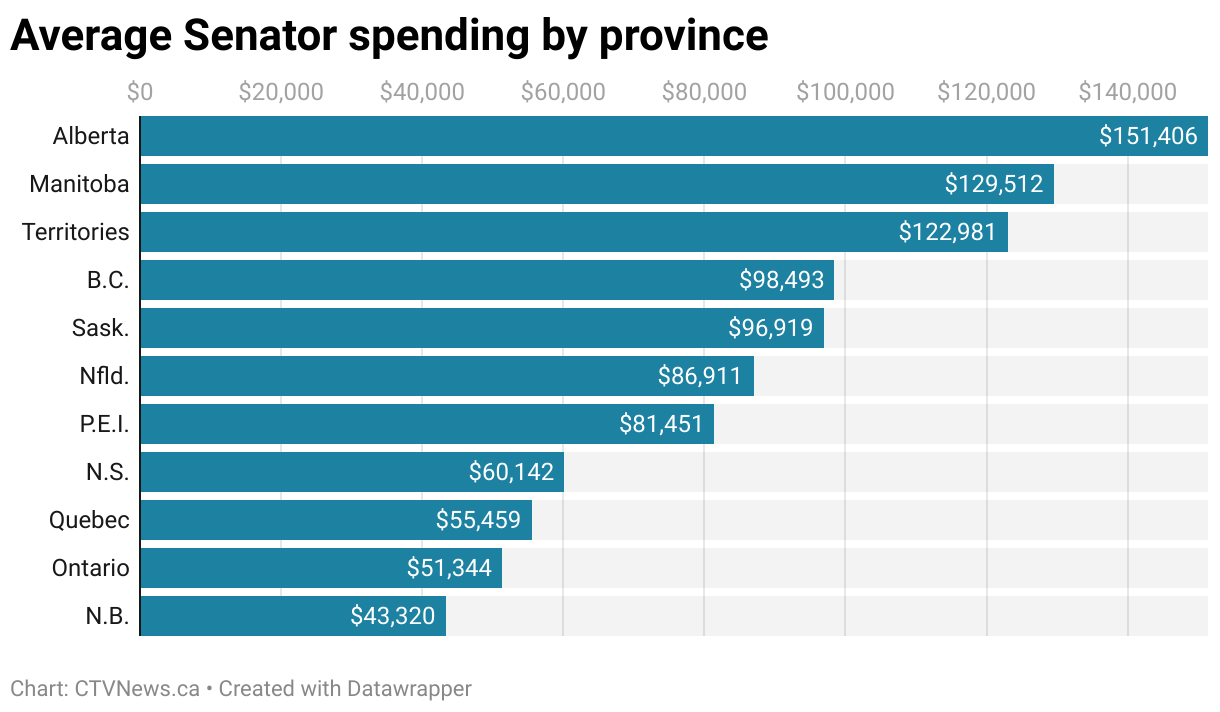Senators in Canada claimed $7.2 million in expenses in 2023, a nearly 30 per cent increase over the previous year.
The total includes almost $4 million for travel, $2.1 million for living costs, $1 million for office expenses and more than $100,000 for hospitality, according to a CTVNews.ca analysis of 101 Senators’ expenses.
The $7.2 million in public money covers costs large and small, like flights, hotels, books, meals, gifts, office supplies, payments to consultants, and thousands of dollars to rent artwork. It does not include costs like senators’ salaries, full-time staffers, administration personnel and committee expenses.
“Since 2015, there have been significant increases in senators’ expenditure,” Queen’s University public policy professor Kathy Brock told CTVNews.ca. “With the movement towards more independent senators who come from a variety of different backgrounds and different orientations towards government, then they come into the Senate and they want to play a more active role.”
Top Senate spenders
Four Senators spent double the average of $71,500, led by Canadian Senators Group leader Scott Tannas at $235,734.18, Conservative Senate leader Donald Plett at $217,596.28, non-affiliated Manitoba Senator Marilou McPhedran at $193,881.47 and recently-retired Nunavut Senator Dennis Glen Patterson at $181,204.47.

McPhedran, who is not part of a Senate caucus, had the highest individual spending of any Senator not in a leadership, officer or facilitator role.
“Simply put, to pursue my parliamentary agenda effectively as an unaffiliated senator with none of the supports enjoyed by senators belonging to a group/caucus, my spending (always within budget allocated to me) is a result of management decisions I make and legislative priorities I champion,” McPhedran said in a written statement to CTVNews.ca.
While many Senators employ three full-time staffers whose salaries are not disclosed, McPhedran only has one.
“As such, comparisons between offices put me at a disadvantage, as I rely less on full-time salaried staff, and have adopted a deliberate cost-effective model of hiring students and subject matter experts on what are termed ‘outside’ contracts,” McPhedran said via email. “I acknowledge that I may not be a typical Senator and that I may be taking on a more demanding way of being a Senator, but this is what I believe is my optimal public service.”
The Red Chamber’s 15 Conservative senators spent the most on average at $94,203.86 each. The 16 members of the Progressive Senate group were the most frugal at an average of $62,164.81 each.
“The Opposition in the Senate is the only caucus/group that takes its role seriously in keeping the government’s feet to the fire in the Upper Chamber,” Conservative Senate leader Donald Plett said in an email to CTVNews.ca. “As Leader of the Opposition, I work diligently in making sure the Trudeau government is accountable on their decisions and have not hesitated in calling out scandals and overall incompetence.”

Just eight senators spent less than half the average amount, excluding those who began or ended their positions in 2023. Only two of these spent under $10,000: Progressive Senator Peter Harder at $5,718.24 and Independent Peter Boehm at $6,963.69.
Approximately 40 Senators also spent at least $96,000 to rent, move and install artwork from the Canada Council for the Arts in the 2023-2024 fiscal year (which runs from April 1 to March 31), according to a Senate spokesperson. Independent Senator René Cormier holds the largest art contracts from 2023, and is spending $12,480 to display 10 pieces of art over four years.
“Senator Cormier is proud to support Canadian artists by leasing their artworks through the Art Bank of the Canada Council for the Arts, utilizing funds approved for this use by the Finance and Procurement Directorate,” the New Brunswick Senator’s office said in a written statement to CTVNews.ca. “This support represents a meaningful investment in promoting Canadian culture and fostering artistic talent, aligning with the Senator’s commitment to enriching the cultural landscape of Canada.”
Roles and geography impact spending
Brock says big differences in spending can boil down to geography, how active a role each Senator takes, and how they handle their office finances.
“With some of the bigger spenders, I noticed that they’re taking more people on the trips with them than other people,” Brock added. “You see a lot of micro expenses, like six dollars for this. They stuck out in my mind, things under $20 – those don’t add up to the big prices, but they do show a shift in the way people are thinking about the fact that they should be reimbursed for any expenditures associated with their job to a greater extent, I think, than in the past.”
With higher travel costs to Ottawa, Senators from the territories and western provinces spent more on average than those from Atlantic Canada, Ontario and Quebec. There were also significantly more in-person Senate work weeks in 2023, which drove up travel costs.

Those in leadership, officer and facilitator roles typically had higher expenses too, and they often covered expenses that benefited other caucus members.
“[T]he leadership office also manages several administrative functions on behalf of the second-largest caucus in the Senate,” Canadian Senators Group leader and top Senate spender Scott Tannas explained in statement to CTVNews.ca. “These include a research bureau providing support to [Canadian Senators Group] senators, additional staff beyond the normal complement assigned to non-leadership senators and information management computer systems. All of which impact my budget and expenditures.”
A ‘spit in the ocean’ or ‘abuse’ of public funds?
CTVNews.ca calculated Senate expenditures for the 2023 calendar year from proactively disclosed quarterly data available on the Senate’s website. The figures represent expenses processed and paid out in 2023, although some may have been incurred previous years. Overall, the $7.2 million in expenses were up from more than $5.6 million in 2022, a 27.6 per cent increase.
Art rentals and other office, travel and hospitality expenses come from an annual budget of more than $250,000 per Senator. There is a $350 limit for purchasing office decorations. Senators are only eligible for living expenses like meals and accommodation if they reside more than 100 kilometres from Parliament Hill. Senators also received a raise in April, with their annual salaries climbing by $8,500 to $178,100.
Incorporating all costs like salaries and administration staff, the Senate’s total planned spending for the 2023-2024 fiscal year was nearly $127 million in taxpayer funds, and expected to reach almost $135 million in 2024-2025.
University of Toronto political science professor emeritus Nelson Wiseman notes that all Senators were within their budgets and said that their expenses are just a “spit in the ocean” for a government that spends billions.
“So my overall impression is, look, they’ve got a budget there for $250,000, whatever they want to do with it is perfectly okay,” Wiseman told CTVNews.ca. “I’m more concerned about the quality of what we’re getting and actually this Senate is the best Senate we’ve had… certainly in the history of the last, I would say 90 to 100 years. And that’s because we actually have people that are acting more independently.”
Duff Conacher is the director and co-founder of Democracy Watch, a non-profit that advocates for democratic reform and government accountability.
“Everything’s a drop in a bucket until it suddenly adds up to the whole bucket,” Conacher told CTVNews.ca. “You don’t just get to abuse public money just because you’re abusing small amounts of the public’s money.”
Referred to as the Red Chamber for its decor, the Senate is the upper house of Canada’s Parliament and has the power to propose legislation and reject bills passed by the elected House of Commons. Unlike the U.S. Senate, the Canadian Senate’s 105 members are not elected, but appointed by the governor general on advice of the prime minister, similar to the British House of Lords. Senators serve until mandatory retirement at age 75. There are currently nine vacant seats.
Senate expenses came under intense scrutiny a decade ago when it was revealed that several senators were claiming travel and living expenses they were not eligible for. The scandal led to rule changes that increased spending transparency. In a push to make the Senate more independent and nonpartisan, the federal Liberals changed the appointment process and removed senators from the Liberal caucus.
“I do think senators are much more conscious of the need to engage in responsible behaviour, so that the Senate doesn’t go through such an embarrassing period as it did when it seemed like it was one person after another who has been caught on something,” Brock said. “The Senate is shifting now, I think it’s trying to find its new identity, essentially, and in some ways it’s moved towards more a culture of policy activism as opposed to being that house of sober second thought.”
Conacher thinks Canada should abolish the Senate, and says Senators’ use of public money for policy activism and pet projects lacks “democratic legitimacy.”
“Senators still have power to spend money on essentially whatever they think is related to their roles as senators, and the Senate rules define their role very broadly as including anything to do with public or political issues,” Conacher explained. “It’s just an undemocratic charade that senators are in this position to do that and bring attention to issues based on their whims.”



